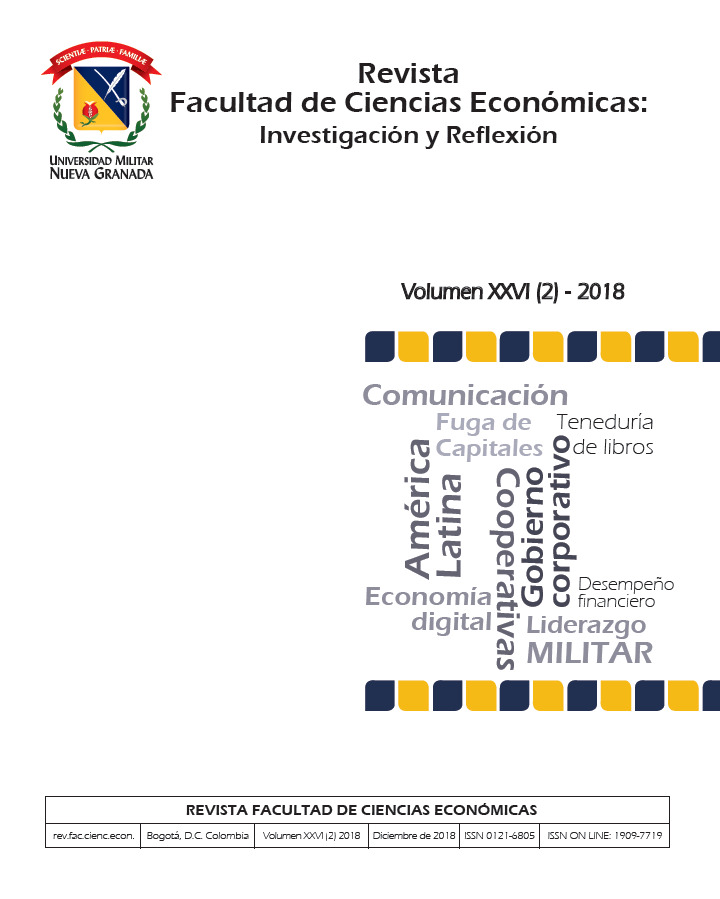La génesis de la teneduría de libros por partida doble
Resumen
La emergencia de la partida doble marcó el cambio en la teneduría de libros de una tarea mecánica a un oficio especializado y representó los inicios de la profesión contable. Este estudio busca identificar qué causó tal cambio significativo, mediante la adopción de la perspectiva de la nueva historia de la contabilidad, es decir, investigando las circunstancias que rodearon el surgimiento de la partida doble a principios de siglo XIII en Italia. Contrario a los hallazgos anteriores, este trabajo concluye que la forma más probable de empresa en la que esta surgió es un banco, con certeza en Florencia. La rendición de cuentas de los bancos locales en esta ciudad al gremio bancario dio un impulso externo único que generó un nuevo modo de teneduría de libros. Este nuevo esquema proporcionó una imagen clara e inequívoca de las cuentas de todos los deudores y acreedores, junto con los medios para verificar que las partidas entre ellos fueran completas y exactas.Descargas
Referencias bibliográficas
Barber, M. (1994). The new knighthood: A history of the order of the temple. Cambridge: Cambridge University Press.
Besta, F. (1909/2007). La ragioneria (2.ª ed., 3 vols.). Roma: Rirea.
Bisson, T. N. (1989). Medieval France and her Pyrenean neighbours: Studies in early institutional history. Londres: The Hambledon Press.
Cajori, F. (1993). A history of mathematical notations. Nueva York: Dover Publications Inc.
De Roover, R. (1937). Aux origines d'une technique intellectuelle: la formation et expansion de la comptabilité à partie double. Annales D'Histoire Économique et Sociale, 9, 270-298.
De Roover, R. (1938). Characteristics of bookkeeping before Paciolo. The Accounting Review, 13(2), 144-149.
De Roover, R. (1955). New perspectives on the history of accounting. The Accounting Review, 30(3), 405-420.
De Roover, R. (1956). The development of accounting prior to Luca Pacioli according to the account-books of mediaeval merchants. En A. C. Littleton y B. S. Yamey (eds.), Studies in the history of accounting (pp. 114-174). Londres: Sweet and Maxwell.
De Roover, R. (1971). The organisation of trade. En M. M., Postan, E. E. Rich y E. Miller (eds.), The Cambridge Economic History of Europe from the Decline of the Roman Empire (vol. 3, pp. 42-118). Cambridge: Cambridge University Press.
Delisle, L. (1889). Mémoire sur les opérations financières des templiers. París: Imprimerie Nationale.
Edler de Roover, F. (1941). Partnership accounts in twelfth century Genoa. Bulletin of the Business Historical Society, 15(6), 87-92. https://doi.org/10.2307/3110601
Flori, L. (1636/1677). Trattato del modo di tenere il libro doppio domestic col suo esemplare. Roma: Lazzari Varese.
Galassi, G. y Mattessich, R. (2004). Italian accounting research in the first half of the 20th century. Review of Accounting and Finance, 3(2), 62-83. https://doi.org/10.1108/eb043403
Gleeson-White, J. (2011). Double entry: How the merchants of Venice shaped the modern world and how their invention could make or break the planet. Sídney: Allen and Unwin.
Goldthwaite, R. A. (1985). Local banking in renaissance Florence. Journal of European Economic History, 14(1), 5-55.
Goldthwaite, R. A. (2009). The economy of renaissance Florence. Baltimore: The Johns Hopkins University Press.
Greif, A., Milgrom, P. y Weingast, B. R. (1994). Coordination, commitment, and enforcement: The case of the merchant guild. Journal of Political Economy, 102(4), 745-776. https://doi.org/10.1086/261953
Gurskaya, M. M., Kuter, M. I., Deliboltoayn, A. E. y Zinchenko, E. S. (2012). The ledgers of Datini Company in Barcelona dated 1397-1399: The transition from double-entry system to double-entry bookkeeping. Ponencia presentada en World Congress of Accounting Historians, Newcastle.
Hall, M. W. (1935). Early bankers in the Genoese notarial records. Economic History Review, 6(1), 73-79. https://doi.org/10.2307/2590032
Kats, P. (1929a). Early history of bookkeeping by double entry. Journal of Accountancy, 47, 203-210.
Kats, P. (1929b). Early history of bookkeeping by double entry. Journal of Accountancy, 47, 275-290.
Kats, P. (1930). A surmise regarding the origin of bookkeeping by double entry. The Accounting Review, 5(4), 311-316.
Kojima, T. (1954). The Japanese abacus: Its use and theory. Rutland: C. E. Tuttle Co. Inc.
Lall Nigam, B. M. (1986). Bahi-Khata: The pre-Pacioli Indian double-entry system of bookkeeping. Abacus, 22(2), 148-161. https://doi.org/10.1111/j.1467-6281.1986.tb00132.x
Lane, F. C. y Mueller, R. C. (1985). Money and banking in medieval and renaissance (vol. 1). Baltimore: The John Hopkins University Press.
Lee, G. A. (1972). The oldest European account book: A Florentine bank ledger of 1211. Nottingham Mediaeval Studies, 16, 28-60. https://doi.org/10.1484/J.NMS.3.55
Lee, G. A. (1973a). The Florentine bank ledger fragments of 1211: Some new insights. Journal of Accounting Research, 11(1), 47-61. https://doi.org/10.2307/2490281
Lee, G. A. (1973b). The development of Italian bookkeeping 1211 to 1300. Abacus, 9(2), 137-155.
https://doi.org/10.1111/j.1467-6281.1973.tb00183.x
Lee, G. A. (1977). The coming of age of double entry: The Giovanni Farolfi ledger of 1299-1300. Abacus, 4(2), 79-95.
Littleton, A. C. (1926). Evolution of the ledger account. The Accounting Review, 1(4), 17-23.
Littleton, A. C. (1927). The antecedents of double-entry. The Accounting Review, 2(2), 140-149.
Littleton, A. C. (1931). Early transaction analysis. The Accounting Review, 6(3), 180-183.
Littleton, A. C. (1933). Accounting evolution to 1900. Nueva York: American Institute Publishing Co.
Lopez, R. S. (1976). The commercial revolution of the middle ages 950-1350. Cambridge: Cambridge University Press. https://doi.org/10.1017/CBO9780511583933
Lord, E. (2004). The Knights Templar in Britain. Abingdon: Routledge.
MacDonald, S. B. y Gastmann, A. L. (2009). A history of credit and power in the Western world. Nuevo Brunswick: Transaction Publishers.
Martinelli, A. (1974). The origination and evolution of double entry bookkeeping to 1440 (Tesis doctoral, Texas State University, Estados Unidos).
Martinelli, A. (1977). Business ventures in Genoa during the twelfth century (1156-1158). The Accounting Historians Journal, 4(1), 55-68. https://doi.org/10.2308/0148-4184.4.1.55
Martinelli, A. (1983). The ledger of Cristianus Lomellinus and Dominicus de Garibaldo, stewards of the city of Genoa (1340-1341). Abacus, 19(2), 83-118. https://doi.org/10.1111/j.1467-6281.1983.tb00242.x
Mattessich, R. (1987). Prehistoric accounting and the problem of representation: On recent archeological evidence of the Middle East from 8,000 B.C. to 3,000 B.C. Accounting Historians Journal, 14(2), 71-91. https://doi.org/10.2308/0148-4184.14.2.71
Mattessich, R. (1994). Accounting as a cultural force: Past, present and future. European Accounting Review, 3(2), 354-374. https://doi.org/10.1080/09638189400000024
Melis, F. (1950). Storia della ragioneria. Bolonia: Cesare Zuffi.
Melis, F. (1954). Ancora sulle origini della partita doppia (in risposta ad un articolo del Prof. R. L. Reynolds). Bollettino Ligustico per la Storia e la Cultura Regionale VI (Genniao-Giugno), 1-12.
Metcalf, D. M. (1980). The Templars as bankers and monetary transfers between West and East in the twelfth century. En P. W. Edbury y D. M. Metcalf (eds.), Coinage in the Latin East: The Fourth Oxford Symposium on Coinage and Monetary History (pp. 1-17). Oxford: British Archaeological Reports.
Miller, P. y Napier, C. (1993). Genealogies of calculation. Accounting, Organizations and Society, 18(7-8), 631-647. https://doi.org/10.1016/0361-3682(93)90047-A
Mueller, R. C. (1979). The role of bank money in Venice 1300-1500. Studi Veneziani, 3, 47-96.
Olsen, G. (1969). Italian merchants and the performance of Papal banking functions in the early thirteenth century. Explorations in Economic History, 7(1), 43-63. https://doi.org/10.1016/0014-4983(69)90044-8
Orlandi, A. (2011). The affirmation of double-entry bookkeeping in the business accounts of Tuscan merchants in the late middle ages. Ponencia presentada en International Conference of Accounting Theory and History, "View from the Past into the Future", San Petersburgo, Rusia. Recuperado de http://www.academia.edu/6598634/The_affirmation_of_doubleentry_bookkeping_in_the_business_accounts_of_Tuscan_in_the_Late_Middle_Ages_Presentation_at_The_International_Conference_of_Accounting_Theory_and_History_View_from_the_Past_into_the_Future_St._Petersburg_February_10-11_2011
Pacioli, L. (1494). Particularis de computis et scripturis. En Summa de Arithmetica Geometria Proportioni et Proportionalita (Ff. 197v-210v). Venecia: Paganino de Paganini.
Peacock, M. S. (2013a). Accounting for money: The legal presuppositions of money and accounting in ancient Greece. Business History, 55(2), 280-301. https://doi.org/10.1080/00076791.2012.704513
Peacock, M. S. (2013b). Introducing money. Abingdon: Routledge. https://doi.org/10.4324/9780203578445
Peragallo, E. (1938). Origin and evolution of double entry bookkeeping. Nueva York: American Institute Publishing Company.
Pietra, A. (1586). Indrizzo de gli economi. Mantua: F. Osanna.
Rossi, G. (1896). La computisteria dei Romani e l'lnvenzione della scrittura doppia. Roma: Società Editrice Dante Alighieri.
Sakamoto, S. I. (1999). The cranmer abacus: Its use in teaching mathematics to students with visual impairments (Tesis doctoral, University of Arizona, Estados Unidos).
Sangster, A., Stoner, G. Scataglini-Belghitar, G., De Lange, P. y O'Connell, B. (2014). Pacioli's example entries: A conundrum resolved? Abacus, 50(1), 93-106. https://doi.org/10.1111/j.1467-6281.2012.00372.x
Santini, P. (1887). Frammenti di um libro di banchieri fiorentini scritto in vulgare nel 1211. Giornale Storica Della Letteratura Italiana, 10, 161-177.
Scorgie, M. E. (1994). Accounting fragments stored in the Old Cairo Genizah. Accounting Business and Financial History, 4(1), 30-41. https://doi.org/10.1080/09585209400000034
Smith, F. (2008a). The influence of Amatino Manucci and Luca Pacioli. Presentación en Gresham College, Londres. Recuperado de http://www.powershow.com/view/148df6-Yzg1Y/The_influence_of_Amatino_Manucci_and_Luca_Pacioli_powerpoint_ppt_presentation
Smith, F. (2008b). The influence of Amatino Manucci and Luca Pacioli. BSHM Bulletin, 23, 143-156. https://doi.org/10.1080/17498430802304016
Sosnowski, R. (2006). Origini della lingua dell'economia in Italia dal XIII Al XVI secolo. Milán: Franco Angeli.
Spufford, P. (1989). Money and its use in medieval Europe. Cambridge: Cambridge University Press.
Staley, E. (1906). The guilds of Florence. Londres: Methuen and Co.
Struik, D. J. (1987). A concise history of mathematics (4.ª ed.). Mineola: Dover Publications Inc.
Tagliente, A. (1525). Considerando … diversi mercanti et molti artesani li quali sanno le sue mercantile ne le loro botege… Venecia.
Udovitch, A. L. (1979). Bankers without banks: Commerce, banking, and society in the Islamic world of the middle ages. En The Dawn of Modern Banking, Center for Medieval and Renaissance Studies (pp. 255-273). New Haven: Yale University Press.
Usher, A. P. (1914). The origin of the bill of exchange. Journal of Political Economy, 22(6), 566-576. https://doi.org/10.1086/252472
Usher, A. P. (1934). The origins of banking: The primitive bank of deposit, 1200-1600. Economic History Review, 4(4), 399-428. https://doi.org/10.2307/2589849
Viganò , E. y Mattessich, R. (2007). Accounting research in Italy: Second half of the 20th century. Review of Accounting and Finance, 6(1), 24-41. https://doi.org/10.1108/14757700710725449
Zerbi, T. (1952). Le origini della partila doppia: Gestioni aziendali e situazioni di mercato nei secoli XIV E XV. Milán: Marzorati.











